Securing a Sustainable Future for Electricity: An Analysis
VerifiedAdded on 2020/05/04
|12
|3061
|57
Essay
AI Summary
This essay delves into the critical aspects of securing a sustainable future for electricity. It examines the environmental impacts, including land and water usage, and pollution from various energy sources. The essay further explores social issues like poverty and urbanization, linking them to energy consumption patterns. Economic factors, such as the high implementation costs of renewable energy projects, are also analyzed. The essay proposes solutions encompassing technological advancements in solar power, waste management, and strategies to address social and economic challenges. The solutions aim to improve technology that will aid in making renewable electricity easy to generate and supplied to the consumers, ultimately advocating for a shift towards sustainable practices and policies to ensure long-term environmental, social, and economic benefits.
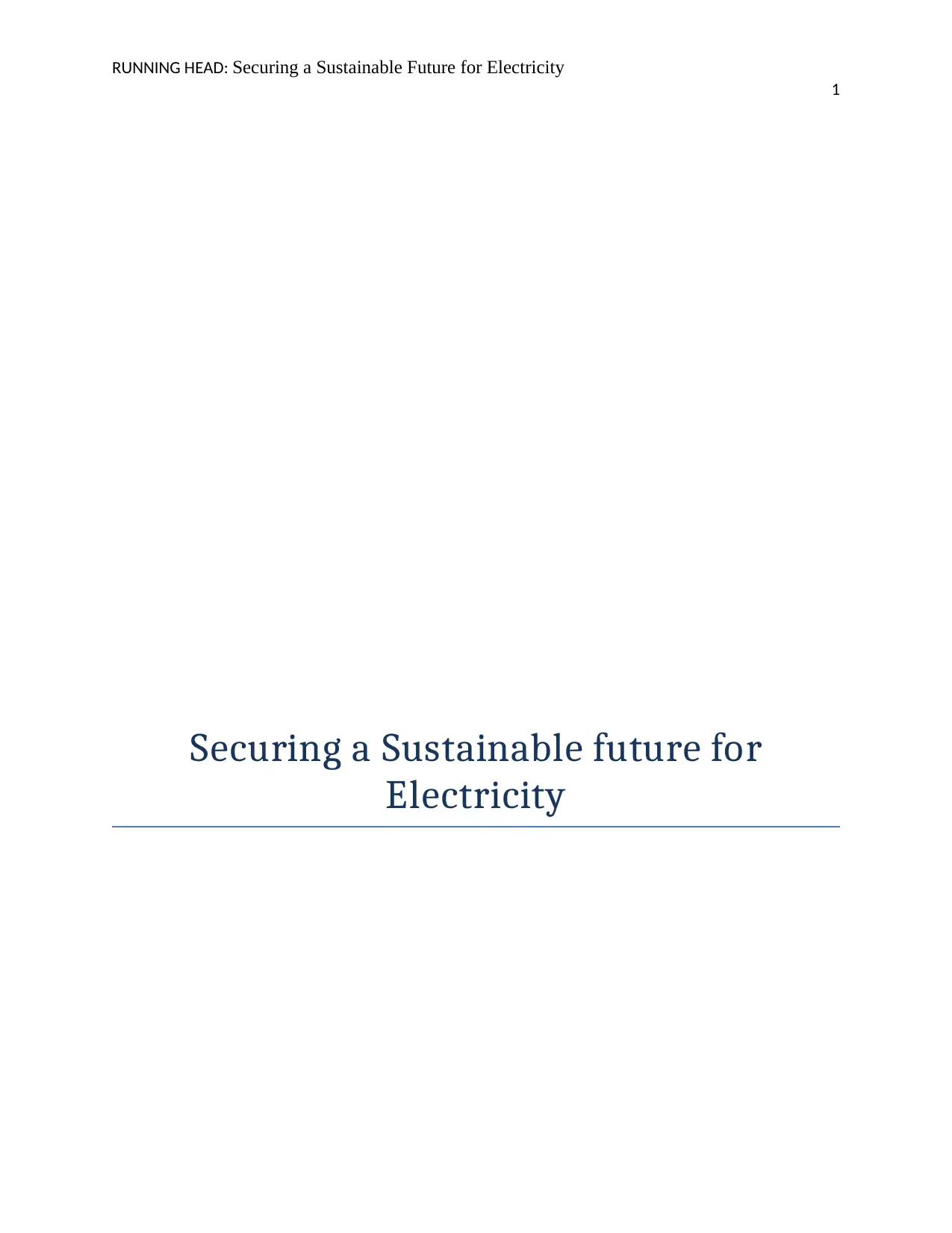
RUNNING HEAD: Securing a Sustainable Future for Electricity
1
Securing a Sustainable future for
Electricity
1
Securing a Sustainable future for
Electricity
Paraphrase This Document
Need a fresh take? Get an instant paraphrase of this document with our AI Paraphraser

Securing a Sustainable Future for Electricity 2
Renewable advancements require higher beginning in investments in infrastructure than fossil
based power frameworks. A move toward low carbon power sources appear to be a fundamental
component of environmental change mitigation techniques. This essay examines the
environmental, economic, social effects and resources needed for the wide scale and worldwide
deployment of different low carbon electricity production advancements. The stakeholder
involvement is progressively becoming a part of developing investment project in order to
convey favorable project results. As each stakeholder in the energy power plants has their own
interest in the project which cause distinctive needs, clashes and has raised the unpredictability
of the project. The report also analyzes the environmental, social, and economic issues related to
electricity and recommends solution for the given issues. The solutions are meant to improve on
technology that will aid in making renewable electricity easy to generate and supplied to the
consumers. According to Verbong & Geels (2010), sustainability may be defined as addressing
own requirements without bargaining the limit of future generations to providing food their own
particular necessities. As such, sustainability is the examination of how typical systems function,
remain different and make every one of that its necessities for nature steady and adjustable. It
likewise perceives that human development takes assets to help the progression way of life. Over
the past decades, since the beginning of electricity new ways have been developed to make
sustainable power. Sustainable electricity is the type of energy that is consumed at ordinary rates
without affecting the atmosphere and its consumers at all. Its consumption is at low levels
contrasted with its supply and impacts (Maxim, 2014). The procurement of energy supplies for a
broadening and the continuously profitable world is one of the biggest issues standing up against
development in the current time. According to Stamford & Azapagic (2012), sustainable energy
source takes a look at both the helpful and fiscal capacity of the renewable energy sources to
cater for this test. The fundamental physical and technological standards behind getting power
from the direct sun-powered, indirect sun-powered, and non-sun oriented energy sources are
categorized within the setting of their ecological impacts, their budgetary issues, and their
prospects. According to Schaltegger et al. (2012), sustainable electricity has various economic,
social, and environmental issues but if well handled by the endeavors of government and society,
it will automatically accomplish long-term sustainable objectives. Better advancement has made
sustainable electricity simple to generate and be supplied to the consumers.
Renewable advancements require higher beginning in investments in infrastructure than fossil
based power frameworks. A move toward low carbon power sources appear to be a fundamental
component of environmental change mitigation techniques. This essay examines the
environmental, economic, social effects and resources needed for the wide scale and worldwide
deployment of different low carbon electricity production advancements. The stakeholder
involvement is progressively becoming a part of developing investment project in order to
convey favorable project results. As each stakeholder in the energy power plants has their own
interest in the project which cause distinctive needs, clashes and has raised the unpredictability
of the project. The report also analyzes the environmental, social, and economic issues related to
electricity and recommends solution for the given issues. The solutions are meant to improve on
technology that will aid in making renewable electricity easy to generate and supplied to the
consumers. According to Verbong & Geels (2010), sustainability may be defined as addressing
own requirements without bargaining the limit of future generations to providing food their own
particular necessities. As such, sustainability is the examination of how typical systems function,
remain different and make every one of that its necessities for nature steady and adjustable. It
likewise perceives that human development takes assets to help the progression way of life. Over
the past decades, since the beginning of electricity new ways have been developed to make
sustainable power. Sustainable electricity is the type of energy that is consumed at ordinary rates
without affecting the atmosphere and its consumers at all. Its consumption is at low levels
contrasted with its supply and impacts (Maxim, 2014). The procurement of energy supplies for a
broadening and the continuously profitable world is one of the biggest issues standing up against
development in the current time. According to Stamford & Azapagic (2012), sustainable energy
source takes a look at both the helpful and fiscal capacity of the renewable energy sources to
cater for this test. The fundamental physical and technological standards behind getting power
from the direct sun-powered, indirect sun-powered, and non-sun oriented energy sources are
categorized within the setting of their ecological impacts, their budgetary issues, and their
prospects. According to Schaltegger et al. (2012), sustainable electricity has various economic,
social, and environmental issues but if well handled by the endeavors of government and society,
it will automatically accomplish long-term sustainable objectives. Better advancement has made
sustainable electricity simple to generate and be supplied to the consumers.
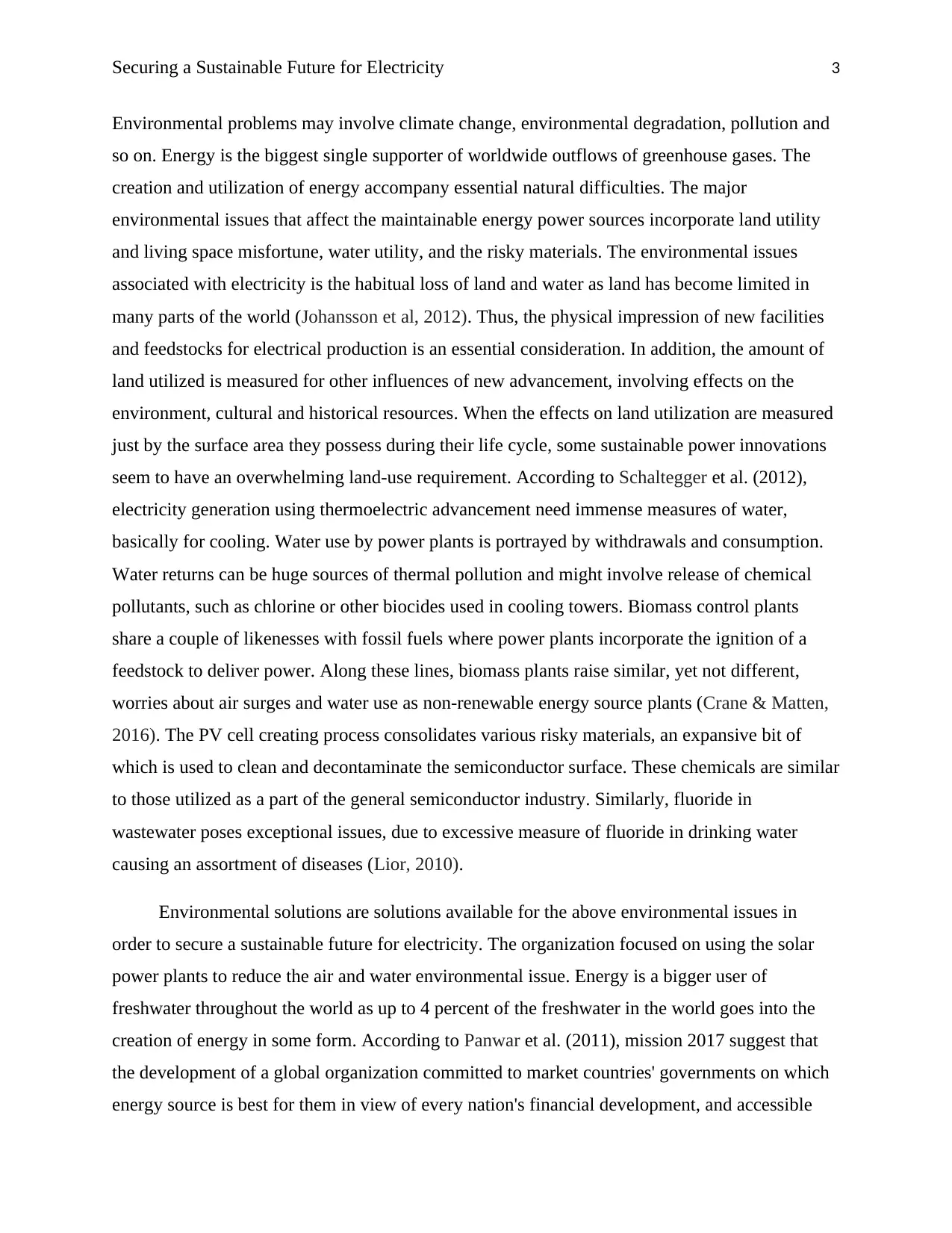
Securing a Sustainable Future for Electricity 3
Environmental problems may involve climate change, environmental degradation, pollution and
so on. Energy is the biggest single supporter of worldwide outflows of greenhouse gases. The
creation and utilization of energy accompany essential natural difficulties. The major
environmental issues that affect the maintainable energy power sources incorporate land utility
and living space misfortune, water utility, and the risky materials. The environmental issues
associated with electricity is the habitual loss of land and water as land has become limited in
many parts of the world (Johansson et al, 2012). Thus, the physical impression of new facilities
and feedstocks for electrical production is an essential consideration. In addition, the amount of
land utilized is measured for other influences of new advancement, involving effects on the
environment, cultural and historical resources. When the effects on land utilization are measured
just by the surface area they possess during their life cycle, some sustainable power innovations
seem to have an overwhelming land-use requirement. According to Schaltegger et al. (2012),
electricity generation using thermoelectric advancement need immense measures of water,
basically for cooling. Water use by power plants is portrayed by withdrawals and consumption.
Water returns can be huge sources of thermal pollution and might involve release of chemical
pollutants, such as chlorine or other biocides used in cooling towers. Biomass control plants
share a couple of likenesses with fossil fuels where power plants incorporate the ignition of a
feedstock to deliver power. Along these lines, biomass plants raise similar, yet not different,
worries about air surges and water use as non-renewable energy source plants (Crane & Matten,
2016). The PV cell creating process consolidates various risky materials, an expansive bit of
which is used to clean and decontaminate the semiconductor surface. These chemicals are similar
to those utilized as a part of the general semiconductor industry. Similarly, fluoride in
wastewater poses exceptional issues, due to excessive measure of fluoride in drinking water
causing an assortment of diseases (Lior, 2010).
Environmental solutions are solutions available for the above environmental issues in
order to secure a sustainable future for electricity. The organization focused on using the solar
power plants to reduce the air and water environmental issue. Energy is a bigger user of
freshwater throughout the world as up to 4 percent of the freshwater in the world goes into the
creation of energy in some form. According to Panwar et al. (2011), mission 2017 suggest that
the development of a global organization committed to market countries' governments on which
energy source is best for them in view of every nation's financial development, and accessible
Environmental problems may involve climate change, environmental degradation, pollution and
so on. Energy is the biggest single supporter of worldwide outflows of greenhouse gases. The
creation and utilization of energy accompany essential natural difficulties. The major
environmental issues that affect the maintainable energy power sources incorporate land utility
and living space misfortune, water utility, and the risky materials. The environmental issues
associated with electricity is the habitual loss of land and water as land has become limited in
many parts of the world (Johansson et al, 2012). Thus, the physical impression of new facilities
and feedstocks for electrical production is an essential consideration. In addition, the amount of
land utilized is measured for other influences of new advancement, involving effects on the
environment, cultural and historical resources. When the effects on land utilization are measured
just by the surface area they possess during their life cycle, some sustainable power innovations
seem to have an overwhelming land-use requirement. According to Schaltegger et al. (2012),
electricity generation using thermoelectric advancement need immense measures of water,
basically for cooling. Water use by power plants is portrayed by withdrawals and consumption.
Water returns can be huge sources of thermal pollution and might involve release of chemical
pollutants, such as chlorine or other biocides used in cooling towers. Biomass control plants
share a couple of likenesses with fossil fuels where power plants incorporate the ignition of a
feedstock to deliver power. Along these lines, biomass plants raise similar, yet not different,
worries about air surges and water use as non-renewable energy source plants (Crane & Matten,
2016). The PV cell creating process consolidates various risky materials, an expansive bit of
which is used to clean and decontaminate the semiconductor surface. These chemicals are similar
to those utilized as a part of the general semiconductor industry. Similarly, fluoride in
wastewater poses exceptional issues, due to excessive measure of fluoride in drinking water
causing an assortment of diseases (Lior, 2010).
Environmental solutions are solutions available for the above environmental issues in
order to secure a sustainable future for electricity. The organization focused on using the solar
power plants to reduce the air and water environmental issue. Energy is a bigger user of
freshwater throughout the world as up to 4 percent of the freshwater in the world goes into the
creation of energy in some form. According to Panwar et al. (2011), mission 2017 suggest that
the development of a global organization committed to market countries' governments on which
energy source is best for them in view of every nation's financial development, and accessible
⊘ This is a preview!⊘
Do you want full access?
Subscribe today to unlock all pages.

Trusted by 1+ million students worldwide
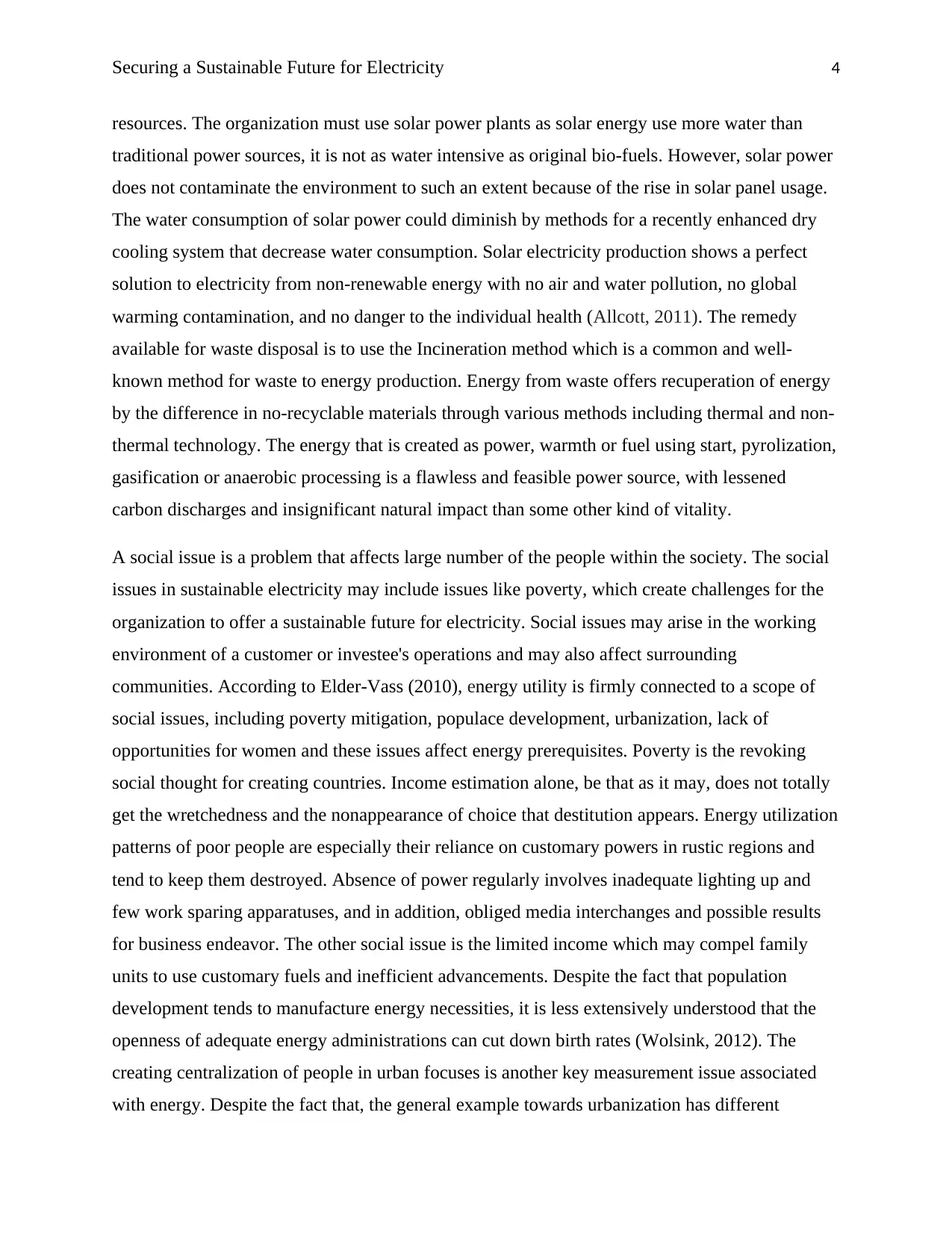
Securing a Sustainable Future for Electricity 4
resources. The organization must use solar power plants as solar energy use more water than
traditional power sources, it is not as water intensive as original bio-fuels. However, solar power
does not contaminate the environment to such an extent because of the rise in solar panel usage.
The water consumption of solar power could diminish by methods for a recently enhanced dry
cooling system that decrease water consumption. Solar electricity production shows a perfect
solution to electricity from non-renewable energy with no air and water pollution, no global
warming contamination, and no danger to the individual health (Allcott, 2011). The remedy
available for waste disposal is to use the Incineration method which is a common and well-
known method for waste to energy production. Energy from waste offers recuperation of energy
by the difference in no-recyclable materials through various methods including thermal and non-
thermal technology. The energy that is created as power, warmth or fuel using start, pyrolization,
gasification or anaerobic processing is a flawless and feasible power source, with lessened
carbon discharges and insignificant natural impact than some other kind of vitality.
A social issue is a problem that affects large number of the people within the society. The social
issues in sustainable electricity may include issues like poverty, which create challenges for the
organization to offer a sustainable future for electricity. Social issues may arise in the working
environment of a customer or investee's operations and may also affect surrounding
communities. According to Elder-Vass (2010), energy utility is firmly connected to a scope of
social issues, including poverty mitigation, populace development, urbanization, lack of
opportunities for women and these issues affect energy prerequisites. Poverty is the revoking
social thought for creating countries. Income estimation alone, be that as it may, does not totally
get the wretchedness and the nonappearance of choice that destitution appears. Energy utilization
patterns of poor people are especially their reliance on customary powers in rustic regions and
tend to keep them destroyed. Absence of power regularly involves inadequate lighting up and
few work sparing apparatuses, and in addition, obliged media interchanges and possible results
for business endeavor. The other social issue is the limited income which may compel family
units to use customary fuels and inefficient advancements. Despite the fact that population
development tends to manufacture energy necessities, it is less extensively understood that the
openness of adequate energy administrations can cut down birth rates (Wolsink, 2012). The
creating centralization of people in urban focuses is another key measurement issue associated
with energy. Despite the fact that, the general example towards urbanization has different
resources. The organization must use solar power plants as solar energy use more water than
traditional power sources, it is not as water intensive as original bio-fuels. However, solar power
does not contaminate the environment to such an extent because of the rise in solar panel usage.
The water consumption of solar power could diminish by methods for a recently enhanced dry
cooling system that decrease water consumption. Solar electricity production shows a perfect
solution to electricity from non-renewable energy with no air and water pollution, no global
warming contamination, and no danger to the individual health (Allcott, 2011). The remedy
available for waste disposal is to use the Incineration method which is a common and well-
known method for waste to energy production. Energy from waste offers recuperation of energy
by the difference in no-recyclable materials through various methods including thermal and non-
thermal technology. The energy that is created as power, warmth or fuel using start, pyrolization,
gasification or anaerobic processing is a flawless and feasible power source, with lessened
carbon discharges and insignificant natural impact than some other kind of vitality.
A social issue is a problem that affects large number of the people within the society. The social
issues in sustainable electricity may include issues like poverty, which create challenges for the
organization to offer a sustainable future for electricity. Social issues may arise in the working
environment of a customer or investee's operations and may also affect surrounding
communities. According to Elder-Vass (2010), energy utility is firmly connected to a scope of
social issues, including poverty mitigation, populace development, urbanization, lack of
opportunities for women and these issues affect energy prerequisites. Poverty is the revoking
social thought for creating countries. Income estimation alone, be that as it may, does not totally
get the wretchedness and the nonappearance of choice that destitution appears. Energy utilization
patterns of poor people are especially their reliance on customary powers in rustic regions and
tend to keep them destroyed. Absence of power regularly involves inadequate lighting up and
few work sparing apparatuses, and in addition, obliged media interchanges and possible results
for business endeavor. The other social issue is the limited income which may compel family
units to use customary fuels and inefficient advancements. Despite the fact that population
development tends to manufacture energy necessities, it is less extensively understood that the
openness of adequate energy administrations can cut down birth rates (Wolsink, 2012). The
creating centralization of people in urban focuses is another key measurement issue associated
with energy. Despite the fact that, the general example towards urbanization has different
Paraphrase This Document
Need a fresh take? Get an instant paraphrase of this document with our AI Paraphraser
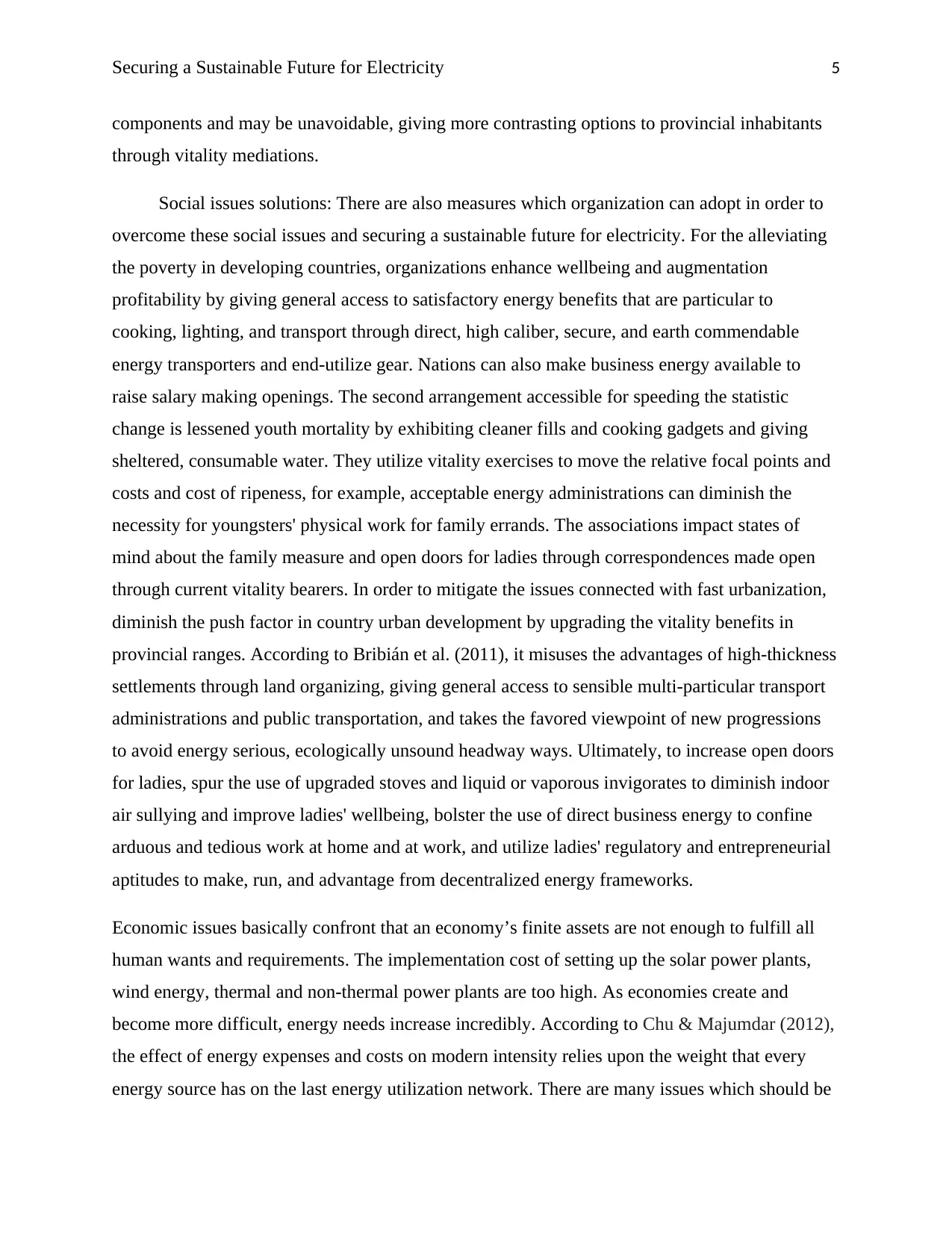
Securing a Sustainable Future for Electricity 5
components and may be unavoidable, giving more contrasting options to provincial inhabitants
through vitality mediations.
Social issues solutions: There are also measures which organization can adopt in order to
overcome these social issues and securing a sustainable future for electricity. For the alleviating
the poverty in developing countries, organizations enhance wellbeing and augmentation
profitability by giving general access to satisfactory energy benefits that are particular to
cooking, lighting, and transport through direct, high caliber, secure, and earth commendable
energy transporters and end-utilize gear. Nations can also make business energy available to
raise salary making openings. The second arrangement accessible for speeding the statistic
change is lessened youth mortality by exhibiting cleaner fills and cooking gadgets and giving
sheltered, consumable water. They utilize vitality exercises to move the relative focal points and
costs and cost of ripeness, for example, acceptable energy administrations can diminish the
necessity for youngsters' physical work for family errands. The associations impact states of
mind about the family measure and open doors for ladies through correspondences made open
through current vitality bearers. In order to mitigate the issues connected with fast urbanization,
diminish the push factor in country urban development by upgrading the vitality benefits in
provincial ranges. According to Bribián et al. (2011), it misuses the advantages of high-thickness
settlements through land organizing, giving general access to sensible multi-particular transport
administrations and public transportation, and takes the favored viewpoint of new progressions
to avoid energy serious, ecologically unsound headway ways. Ultimately, to increase open doors
for ladies, spur the use of upgraded stoves and liquid or vaporous invigorates to diminish indoor
air sullying and improve ladies' wellbeing, bolster the use of direct business energy to confine
arduous and tedious work at home and at work, and utilize ladies' regulatory and entrepreneurial
aptitudes to make, run, and advantage from decentralized energy frameworks.
Economic issues basically confront that an economy’s finite assets are not enough to fulfill all
human wants and requirements. The implementation cost of setting up the solar power plants,
wind energy, thermal and non-thermal power plants are too high. As economies create and
become more difficult, energy needs increase incredibly. According to Chu & Majumdar (2012),
the effect of energy expenses and costs on modern intensity relies upon the weight that every
energy source has on the last energy utilization network. There are many issues which should be
components and may be unavoidable, giving more contrasting options to provincial inhabitants
through vitality mediations.
Social issues solutions: There are also measures which organization can adopt in order to
overcome these social issues and securing a sustainable future for electricity. For the alleviating
the poverty in developing countries, organizations enhance wellbeing and augmentation
profitability by giving general access to satisfactory energy benefits that are particular to
cooking, lighting, and transport through direct, high caliber, secure, and earth commendable
energy transporters and end-utilize gear. Nations can also make business energy available to
raise salary making openings. The second arrangement accessible for speeding the statistic
change is lessened youth mortality by exhibiting cleaner fills and cooking gadgets and giving
sheltered, consumable water. They utilize vitality exercises to move the relative focal points and
costs and cost of ripeness, for example, acceptable energy administrations can diminish the
necessity for youngsters' physical work for family errands. The associations impact states of
mind about the family measure and open doors for ladies through correspondences made open
through current vitality bearers. In order to mitigate the issues connected with fast urbanization,
diminish the push factor in country urban development by upgrading the vitality benefits in
provincial ranges. According to Bribián et al. (2011), it misuses the advantages of high-thickness
settlements through land organizing, giving general access to sensible multi-particular transport
administrations and public transportation, and takes the favored viewpoint of new progressions
to avoid energy serious, ecologically unsound headway ways. Ultimately, to increase open doors
for ladies, spur the use of upgraded stoves and liquid or vaporous invigorates to diminish indoor
air sullying and improve ladies' wellbeing, bolster the use of direct business energy to confine
arduous and tedious work at home and at work, and utilize ladies' regulatory and entrepreneurial
aptitudes to make, run, and advantage from decentralized energy frameworks.
Economic issues basically confront that an economy’s finite assets are not enough to fulfill all
human wants and requirements. The implementation cost of setting up the solar power plants,
wind energy, thermal and non-thermal power plants are too high. As economies create and
become more difficult, energy needs increase incredibly. According to Chu & Majumdar (2012),
the effect of energy expenses and costs on modern intensity relies upon the weight that every
energy source has on the last energy utilization network. There are many issues which should be
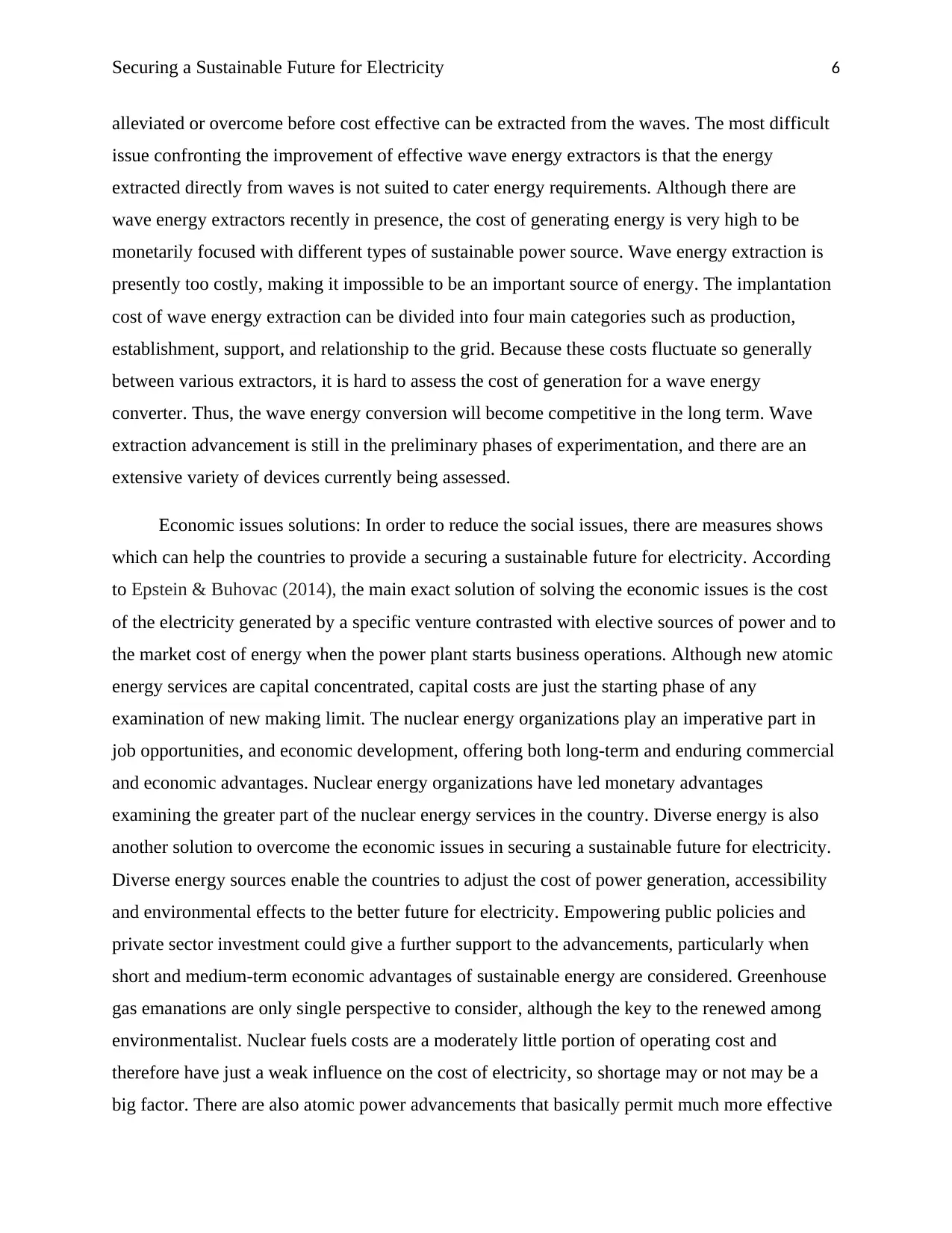
Securing a Sustainable Future for Electricity 6
alleviated or overcome before cost effective can be extracted from the waves. The most difficult
issue confronting the improvement of effective wave energy extractors is that the energy
extracted directly from waves is not suited to cater energy requirements. Although there are
wave energy extractors recently in presence, the cost of generating energy is very high to be
monetarily focused with different types of sustainable power source. Wave energy extraction is
presently too costly, making it impossible to be an important source of energy. The implantation
cost of wave energy extraction can be divided into four main categories such as production,
establishment, support, and relationship to the grid. Because these costs fluctuate so generally
between various extractors, it is hard to assess the cost of generation for a wave energy
converter. Thus, the wave energy conversion will become competitive in the long term. Wave
extraction advancement is still in the preliminary phases of experimentation, and there are an
extensive variety of devices currently being assessed.
Economic issues solutions: In order to reduce the social issues, there are measures shows
which can help the countries to provide a securing a sustainable future for electricity. According
to Epstein & Buhovac (2014), the main exact solution of solving the economic issues is the cost
of the electricity generated by a specific venture contrasted with elective sources of power and to
the market cost of energy when the power plant starts business operations. Although new atomic
energy services are capital concentrated, capital costs are just the starting phase of any
examination of new making limit. The nuclear energy organizations play an imperative part in
job opportunities, and economic development, offering both long-term and enduring commercial
and economic advantages. Nuclear energy organizations have led monetary advantages
examining the greater part of the nuclear energy services in the country. Diverse energy is also
another solution to overcome the economic issues in securing a sustainable future for electricity.
Diverse energy sources enable the countries to adjust the cost of power generation, accessibility
and environmental effects to the better future for electricity. Empowering public policies and
private sector investment could give a further support to the advancements, particularly when
short and medium-term economic advantages of sustainable energy are considered. Greenhouse
gas emanations are only single perspective to consider, although the key to the renewed among
environmentalist. Nuclear fuels costs are a moderately little portion of operating cost and
therefore have just a weak influence on the cost of electricity, so shortage may or not may be a
big factor. There are also atomic power advancements that basically permit much more effective
alleviated or overcome before cost effective can be extracted from the waves. The most difficult
issue confronting the improvement of effective wave energy extractors is that the energy
extracted directly from waves is not suited to cater energy requirements. Although there are
wave energy extractors recently in presence, the cost of generating energy is very high to be
monetarily focused with different types of sustainable power source. Wave energy extraction is
presently too costly, making it impossible to be an important source of energy. The implantation
cost of wave energy extraction can be divided into four main categories such as production,
establishment, support, and relationship to the grid. Because these costs fluctuate so generally
between various extractors, it is hard to assess the cost of generation for a wave energy
converter. Thus, the wave energy conversion will become competitive in the long term. Wave
extraction advancement is still in the preliminary phases of experimentation, and there are an
extensive variety of devices currently being assessed.
Economic issues solutions: In order to reduce the social issues, there are measures shows
which can help the countries to provide a securing a sustainable future for electricity. According
to Epstein & Buhovac (2014), the main exact solution of solving the economic issues is the cost
of the electricity generated by a specific venture contrasted with elective sources of power and to
the market cost of energy when the power plant starts business operations. Although new atomic
energy services are capital concentrated, capital costs are just the starting phase of any
examination of new making limit. The nuclear energy organizations play an imperative part in
job opportunities, and economic development, offering both long-term and enduring commercial
and economic advantages. Nuclear energy organizations have led monetary advantages
examining the greater part of the nuclear energy services in the country. Diverse energy is also
another solution to overcome the economic issues in securing a sustainable future for electricity.
Diverse energy sources enable the countries to adjust the cost of power generation, accessibility
and environmental effects to the better future for electricity. Empowering public policies and
private sector investment could give a further support to the advancements, particularly when
short and medium-term economic advantages of sustainable energy are considered. Greenhouse
gas emanations are only single perspective to consider, although the key to the renewed among
environmentalist. Nuclear fuels costs are a moderately little portion of operating cost and
therefore have just a weak influence on the cost of electricity, so shortage may or not may be a
big factor. There are also atomic power advancements that basically permit much more effective
⊘ This is a preview!⊘
Do you want full access?
Subscribe today to unlock all pages.

Trusted by 1+ million students worldwide
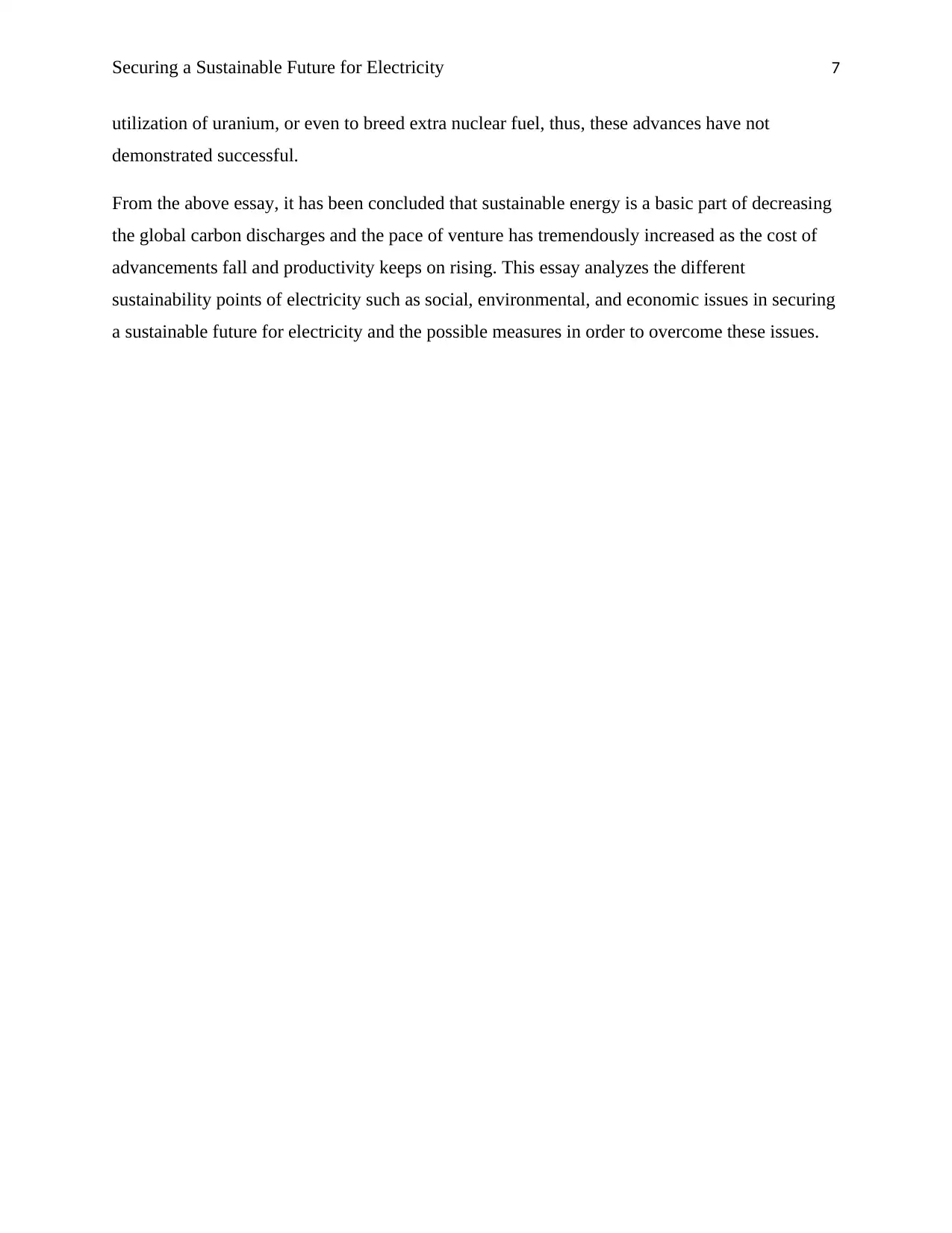
Securing a Sustainable Future for Electricity 7
utilization of uranium, or even to breed extra nuclear fuel, thus, these advances have not
demonstrated successful.
From the above essay, it has been concluded that sustainable energy is a basic part of decreasing
the global carbon discharges and the pace of venture has tremendously increased as the cost of
advancements fall and productivity keeps on rising. This essay analyzes the different
sustainability points of electricity such as social, environmental, and economic issues in securing
a sustainable future for electricity and the possible measures in order to overcome these issues.
utilization of uranium, or even to breed extra nuclear fuel, thus, these advances have not
demonstrated successful.
From the above essay, it has been concluded that sustainable energy is a basic part of decreasing
the global carbon discharges and the pace of venture has tremendously increased as the cost of
advancements fall and productivity keeps on rising. This essay analyzes the different
sustainability points of electricity such as social, environmental, and economic issues in securing
a sustainable future for electricity and the possible measures in order to overcome these issues.
Paraphrase This Document
Need a fresh take? Get an instant paraphrase of this document with our AI Paraphraser
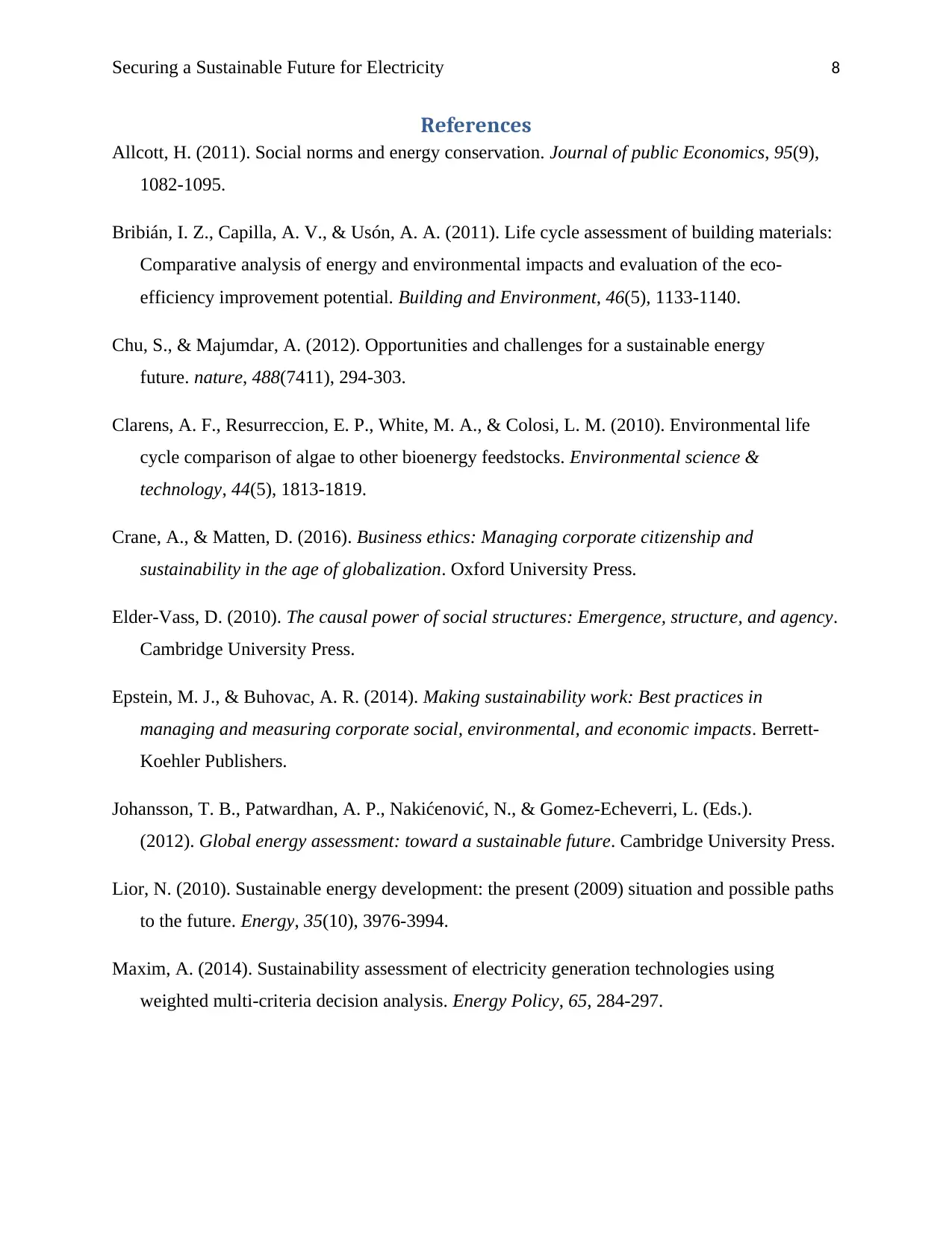
Securing a Sustainable Future for Electricity 8
References
Allcott, H. (2011). Social norms and energy conservation. Journal of public Economics, 95(9),
1082-1095.
Bribián, I. Z., Capilla, A. V., & Usón, A. A. (2011). Life cycle assessment of building materials:
Comparative analysis of energy and environmental impacts and evaluation of the eco-
efficiency improvement potential. Building and Environment, 46(5), 1133-1140.
Chu, S., & Majumdar, A. (2012). Opportunities and challenges for a sustainable energy
future. nature, 488(7411), 294-303.
Clarens, A. F., Resurreccion, E. P., White, M. A., & Colosi, L. M. (2010). Environmental life
cycle comparison of algae to other bioenergy feedstocks. Environmental science &
technology, 44(5), 1813-1819.
Crane, A., & Matten, D. (2016). Business ethics: Managing corporate citizenship and
sustainability in the age of globalization. Oxford University Press.
Elder-Vass, D. (2010). The causal power of social structures: Emergence, structure, and agency.
Cambridge University Press.
Epstein, M. J., & Buhovac, A. R. (2014). Making sustainability work: Best practices in
managing and measuring corporate social, environmental, and economic impacts. Berrett-
Koehler Publishers.
Johansson, T. B., Patwardhan, A. P., Nakićenović, N., & Gomez-Echeverri, L. (Eds.).
(2012). Global energy assessment: toward a sustainable future. Cambridge University Press.
Lior, N. (2010). Sustainable energy development: the present (2009) situation and possible paths
to the future. Energy, 35(10), 3976-3994.
Maxim, A. (2014). Sustainability assessment of electricity generation technologies using
weighted multi-criteria decision analysis. Energy Policy, 65, 284-297.
References
Allcott, H. (2011). Social norms and energy conservation. Journal of public Economics, 95(9),
1082-1095.
Bribián, I. Z., Capilla, A. V., & Usón, A. A. (2011). Life cycle assessment of building materials:
Comparative analysis of energy and environmental impacts and evaluation of the eco-
efficiency improvement potential. Building and Environment, 46(5), 1133-1140.
Chu, S., & Majumdar, A. (2012). Opportunities and challenges for a sustainable energy
future. nature, 488(7411), 294-303.
Clarens, A. F., Resurreccion, E. P., White, M. A., & Colosi, L. M. (2010). Environmental life
cycle comparison of algae to other bioenergy feedstocks. Environmental science &
technology, 44(5), 1813-1819.
Crane, A., & Matten, D. (2016). Business ethics: Managing corporate citizenship and
sustainability in the age of globalization. Oxford University Press.
Elder-Vass, D. (2010). The causal power of social structures: Emergence, structure, and agency.
Cambridge University Press.
Epstein, M. J., & Buhovac, A. R. (2014). Making sustainability work: Best practices in
managing and measuring corporate social, environmental, and economic impacts. Berrett-
Koehler Publishers.
Johansson, T. B., Patwardhan, A. P., Nakićenović, N., & Gomez-Echeverri, L. (Eds.).
(2012). Global energy assessment: toward a sustainable future. Cambridge University Press.
Lior, N. (2010). Sustainable energy development: the present (2009) situation and possible paths
to the future. Energy, 35(10), 3976-3994.
Maxim, A. (2014). Sustainability assessment of electricity generation technologies using
weighted multi-criteria decision analysis. Energy Policy, 65, 284-297.
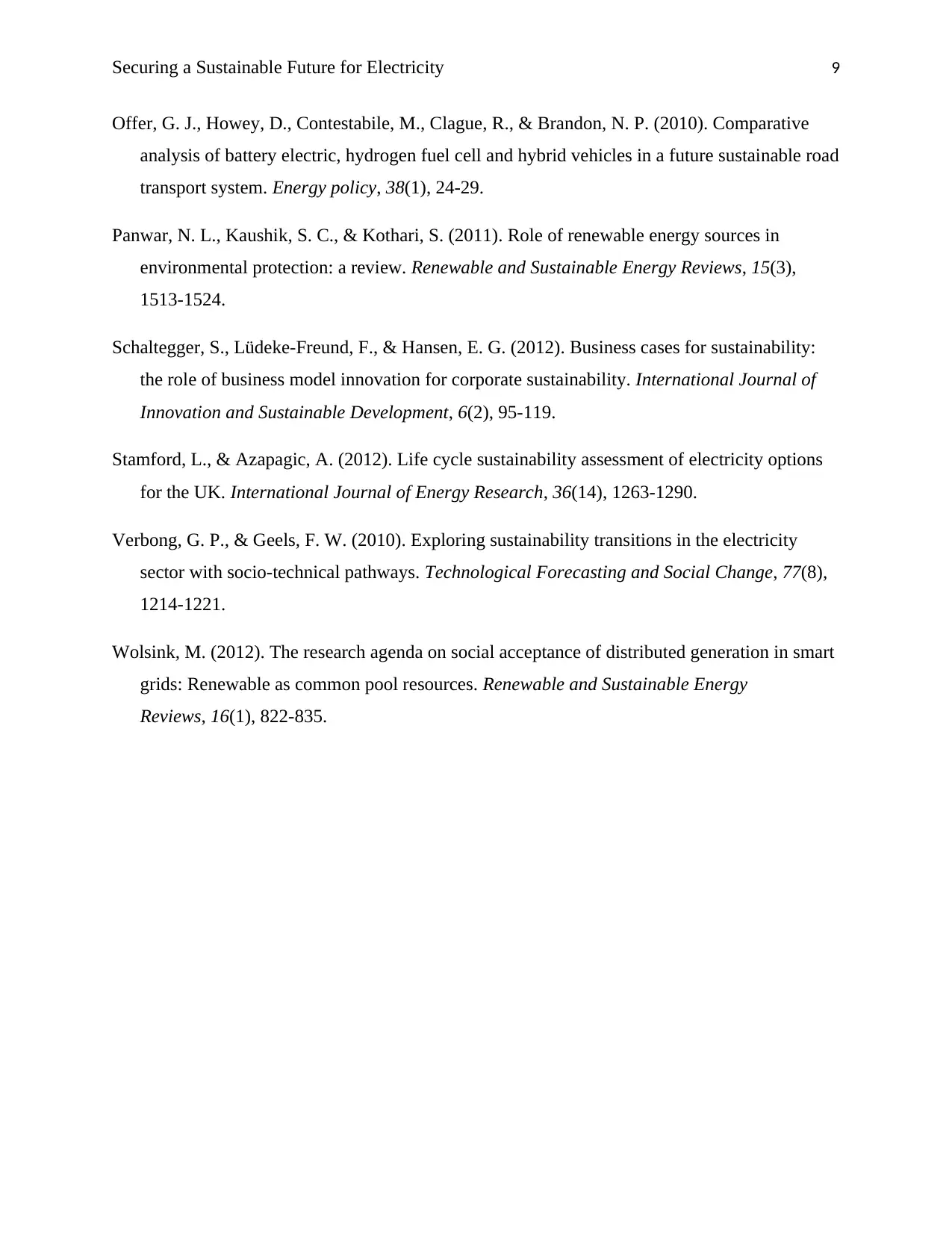
Securing a Sustainable Future for Electricity 9
Offer, G. J., Howey, D., Contestabile, M., Clague, R., & Brandon, N. P. (2010). Comparative
analysis of battery electric, hydrogen fuel cell and hybrid vehicles in a future sustainable road
transport system. Energy policy, 38(1), 24-29.
Panwar, N. L., Kaushik, S. C., & Kothari, S. (2011). Role of renewable energy sources in
environmental protection: a review. Renewable and Sustainable Energy Reviews, 15(3),
1513-1524.
Schaltegger, S., Lüdeke-Freund, F., & Hansen, E. G. (2012). Business cases for sustainability:
the role of business model innovation for corporate sustainability. International Journal of
Innovation and Sustainable Development, 6(2), 95-119.
Stamford, L., & Azapagic, A. (2012). Life cycle sustainability assessment of electricity options
for the UK. International Journal of Energy Research, 36(14), 1263-1290.
Verbong, G. P., & Geels, F. W. (2010). Exploring sustainability transitions in the electricity
sector with socio-technical pathways. Technological Forecasting and Social Change, 77(8),
1214-1221.
Wolsink, M. (2012). The research agenda on social acceptance of distributed generation in smart
grids: Renewable as common pool resources. Renewable and Sustainable Energy
Reviews, 16(1), 822-835.
Offer, G. J., Howey, D., Contestabile, M., Clague, R., & Brandon, N. P. (2010). Comparative
analysis of battery electric, hydrogen fuel cell and hybrid vehicles in a future sustainable road
transport system. Energy policy, 38(1), 24-29.
Panwar, N. L., Kaushik, S. C., & Kothari, S. (2011). Role of renewable energy sources in
environmental protection: a review. Renewable and Sustainable Energy Reviews, 15(3),
1513-1524.
Schaltegger, S., Lüdeke-Freund, F., & Hansen, E. G. (2012). Business cases for sustainability:
the role of business model innovation for corporate sustainability. International Journal of
Innovation and Sustainable Development, 6(2), 95-119.
Stamford, L., & Azapagic, A. (2012). Life cycle sustainability assessment of electricity options
for the UK. International Journal of Energy Research, 36(14), 1263-1290.
Verbong, G. P., & Geels, F. W. (2010). Exploring sustainability transitions in the electricity
sector with socio-technical pathways. Technological Forecasting and Social Change, 77(8),
1214-1221.
Wolsink, M. (2012). The research agenda on social acceptance of distributed generation in smart
grids: Renewable as common pool resources. Renewable and Sustainable Energy
Reviews, 16(1), 822-835.
⊘ This is a preview!⊘
Do you want full access?
Subscribe today to unlock all pages.

Trusted by 1+ million students worldwide

Securing a Sustainable Future for Electricity 10
Paraphrase This Document
Need a fresh take? Get an instant paraphrase of this document with our AI Paraphraser

Securing a Sustainable Future for Electricity 11

Securing a Sustainable Future for Electricity 12
⊘ This is a preview!⊘
Do you want full access?
Subscribe today to unlock all pages.

Trusted by 1+ million students worldwide
1 out of 12
Related Documents
Your All-in-One AI-Powered Toolkit for Academic Success.
+13062052269
info@desklib.com
Available 24*7 on WhatsApp / Email
![[object Object]](/_next/static/media/star-bottom.7253800d.svg)
Unlock your academic potential
Copyright © 2020–2025 A2Z Services. All Rights Reserved. Developed and managed by ZUCOL.





